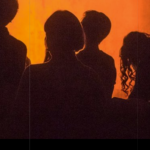Jane’s blog is a detailed record of her thoughts on both her individual and collective projects; she sought to make the Anthropocene ecological crisis the central topic of her exhibition practice. In the third week, she built this topic by researching the toolkit and documenting the new ecological principles she had learned to incorporate into her thinking. In the fourth week’s ethical blog, Jane summarized the theories and critically remarked on curatorial theories, as well as discussing her own exhibition and advocating a softer approach. Jane has also provided comprehensive analysis and explanation to the choice of site and location for the exhibition, selecting Edinburgh as the appropriate location for a site visit that would make the project practical.
In terms of the venue’s layout, Jane has chosen various works of art, such as Katie Paterson, but I’m confused about how to arrange them; what order should we place these many works in? The interpretation of works of art is primarily determined by the curator’s creative activity and the space that he creates for presentation (Tahlina, 2021). If initial connotations were limited to the curator’s role as a guardian and caretaker of collections, then the curator himself/herself is a creative subject in the modern sense (Tahlina, 2021). So, as a creative subject concerning humans and the environment, how to artistically construct the location to connect the artifacts is also a key aspect of exhibition curating.
I’ve been reflecting on my own curatorial process through Jane’s peer review, and Jane has mentioned group work in several of her blogs, whereas I’ve recorded less of it, only mentioning the discussions we had in the first few weeks, and that we’re nearing the end of the collective project’s creation, so I’ll be adding to my blogs in the coming weeks to reflect on group activities. For site planning, I did not adequately describe the Fruitmarket Gallery, which I chose, and I should provide more information on this venue to better my grasp of the unique project. Furthermore, I did not adequately integrate my personal project with the course theory and did not include it into my own curatorial plan after some theoretical analyses, which I will also include in my later revisions.
Overall, Jane’s curatorial plan is now more complete, and we will be discussing everyone’s projects during group activities after class, as well as critically reflecting on additional members’ projects with the help of our group members.
Reference:
- Pearce, Susan. “From Classification to Recreated ‘Reality’: William Bullock’s Exhibitions of Human and Natural History.” Journal for eighteenth-century studies 43.4 (2020): 507–524.
- Michalowska, Marianna. “Artists in the Face of Threats of Climate Change.” Oceanologia 62.4 (2020): 565–575.
- Tahlina, Y. S., & Kutenko, O. S. (2021). THE ROLE OF THE PRINCIPLE OF CURATION IN THE CONTEMPORARY CULTURE . The Journal of V. N. Karazin Kharkiv National University. Series “Theory of Culture and Philosophy of Science”, (63), 68-76.




